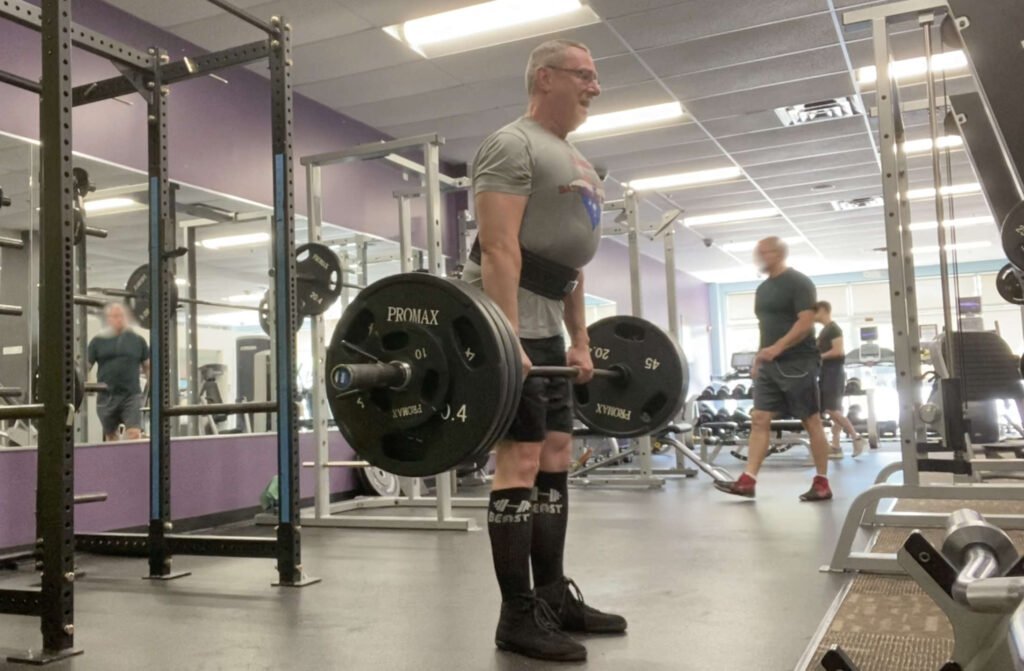[ad_1]
Weight training is dangerous…. or is it???
The fact of growing older usually means being more prone to getting injured.
It might also be argued that these injuries are more impactful and take longer to recover from than when young.
This is true even after all the benefits gained from weight training (improved muscle mass, improved bone density, stronger ligaments and tendons, strengthening of the heart etc.)
So we need ways in which to stay safe even when using heavy weights.
I’ll get to that, but first a little background…
I have found that injuries can manifest themselves in different ways to the ‘general population’, and these will sometimes be a surprise.
Snapped my gastrocnemius muscle
This happened a few months ago…
I was getting back to form after nursing a bruised rib and decided, on a whim on an ‘off-day’, to see where I was at in terms of strength.
This turned out to be a silly move as it was not part of my training schedule.
All was going great until I did my last deadlift pull of 335.
Just as I was locking out I heard this almighty snap from my left calf.
I had been recording the pull with my phone so I could analyze it for any form issues.
Little did I know until later that evening that the snap was clearly heard on the video and not just in my head!
Below is the video – I’m sorry about the fan running and you may have to turn the volume up to hear the snap, but I can assure you it was there.
I do remember in my head at the time thinking that I didn’t fall over so I’d complete the lift!
Based upon my personal experience with some injuries I have come up with my top tips that I hope will be useful.
I have mostly kept to these tips and as a result my injuries have been few and far between, with most other issues just coming from daily life and the occasional accidental fall or trip etc.
Tip 1 – Don’t be afraid to deload
What is a deload?
A deload is when you keep training but you set aside one or two weeks to allow your body to recover from the training stress you have been subjecting it to through your program.
In simple terms you will be lifting less weight, and it may – in some circumstances – involve less volume than you are used to as well.
When to deload
For a general (non-competitive) older weight trainer who uses barbells this will be more often than you think.
Indeed the time to deload is probably the time you least want to, or expect to.
There will be progressions in training when the body will be making some major adaptations and all will be feeling strong and really good.
The problem with this is that while there may be increasing muscle mass, other body parts – in particular the tendons – may not be improving at the same rate.
An injury will typically come from the weakest point and is usually aggravated with a breakdown in form.
If you are pushing your weights close to your maximum, or you are hitting new personal records then the temptation is to keep going.
For the older person this is the time to deload and your body will thank you for it.
Tip 2 – Use accessory movements with care
For the novice I would say that accessory movements are not really necessary.
The benefits from the four compound movements of squat, bench, press and deadlift are sufficient.
As training progresses it can be very useful to layer in accessory movements to train certain targeted muscles.
However as a masters athlete accessories should be used with caution for the very reason they are targeted.
You may end up over working a particular muscle, especially if it is a smaller one.
If not the muscle then you may aggravate some tendonitis, again through overwork.
Use and pick accessories movements carefully and only use them in moderation.
Over time more volume can be added, but only after the body has adapted to handle it.
As a rule of thumb you want to do enough weight and volume that you can feel the fatigue, but not so much that you haven’t fully recovered within 48 hours.
It is much better to start out conservatively with the weight, sets and reps and steadily add to these each week than to do go too heavy too soon and have to pull everything back due to the delayed onset muscle soreness (DOMS) caused by doing this.
Tip 3 – More volume can be better than more weight
This is somewhat related to the tip to deload but is more about adding higher volume and lower weight (so-called intensity) into the programming schedule.
This can allow the body to recover while still moving the same, or similar, tonnage.
Tonnage is defined as the weight x the number of reps.
So if the weight is reduced but the volume is increased then the same or even more total weight can be moved but with less overall stress to the body.
This can keep progress on track without compromising form and stimulus that will cause an adaptation.
For older strength trainers this should be a regular part of your training strategy and schedule.
If it not then you should speak to your coach and have a discussion on where this can be added to help prevent injury.
Tip 4 – Warm up correctly
Us older fifty plus weight trainers need to make sure that we prime our muscles, tendons and nervous system for the training session about to be tackled.
To be frank doing a 10 or 15 minute session on a treadmill isn’t going to cut it.
That may work for the younger crowd but can be a recipe for injury.
If you are going to start the training session squatting then that should be the type of warm up.
I detail my personal warm up routine, but as long as the warm up exercises are close to the activity to be undertaken it should suffice.
The goal is to ensure that blood is flowing to the correct areas and that you’re doing appropriate stretches.
Never go into the planned working set without first working up to that weight.
You’ll never see powerlifting or strongmen competitors just going straight into the planned weight.
They will start off light and work up.
Tip 5 – Consistency is your friend
If we consider that our bodies are simply machines that like familiar routines then it isn’t a stretch to realize that our bodies really appreciate consistency.
This means having a set schedule and time, as best as your schedule will allow, that is dedicated to the workout sessions.
Aging bodies do not appreciate being worked on off hours or on the spur of the moment.
There is very much a mental component to successfully working out and if the brain is trained to know what to expect it will co-ordinate through the nervous system to ensure everything is firing correctly.
Catch it off-guard and this may not happen correctly and a form breakdown can easily cause an injury.
Not only is a consistent schedule better for overall health but in can be a great defense against getting injured.
Tip 6 – Wear a belt carefully
I added this because of personal experience.
When I started out, and for the first two years of my strength training journey I used a leather single prong belt with a ‘medium’ thickness.
This served me well until I progressed to heavy weights, particularly when squatting.
I decided to purchase a lever powerlifting belt that is extremely sturdy and thick.
It is quite the contraption and you need to carry a screwdriver around with you for when you need to alter the girth.
Not knowing any better I had my belt on too tight and as I squatted and held my valsava the belt wasn’t going to budge and the only thing that was going to give way were my ribs!
The upshot was that I bruised my ribs … to the extent that I couldn’t deadlift light weight without significant pain.
Needless to say I had to dial back my training program, focusing mainly on benching, until the bruising had healed.
I also too one notch out of the belt to loosen it off and subsequently haven’t had that issue again.
Lesson learned!
Tip 7 – Don’t chase singles
It is highly likely that you’re not weight training to enter any powerlifting or strengthlifting competitions.
Even if you are there is a training schedule where you work yourself up for peaking to be able to hit single one rep maxes.
Other than that they really shouldn’t be a thing.
If you are pushing yourself to do maximum effort singles, the older you are the more likely it will result in injury.
Avoid the temptation – unless your program has a taper and peak phase.
Much better is to keep a record of your 3 or 5 rep max efforts.
As an overall strength training goal lifting with good form and control at these rep ranges will not only be more productive to adaptations leading to increased strength, but they should prevent you from straying into injury territory.
Click here to get Lupus Holistic Care Plan discounted price while it’s still available…
[ad_2]


